
Restio, Elegia capensis: planting, pruning and care
Contents
Restio, in a nutshell
- These rare plants form tufts of finely divided leaves, sometimes imposing, resembling rushes or bamboos and displaying extraordinary diversity.
- Native to South Africa, they offer striking architectural form and an incomparable exotic touch with their terminal plumes of flowers.
- Restios are relatively easy to grow in a mild climate, in acidic to neutral soil, from dry to moist depending on species.
- They can also be grown in containers on a balcony or terrace, providing screening, with protection against excessive cold.
A word from our expert
Restios or South African reeds, of which Elegia capensis or restio horsetail is best known in France, are astonishing evergreen herbaceous perennial plants that, depending on their size, combine aspects of rushes, grasses (Thamnochortus pluristachyus ), horsetail or even bamboos reaching 2.50 m high like Rhodocoma gigantea. Within fynbos in South Africa they form the large family Restionaceae, equivalent to grasses in our regions.
These tender plants, mostly native to South Africa but also to Australia, are poorly suited to cold climates as their hardiness ranges from -5°C to -12°C at most. They generally grow in poor schistose, sandstone or sandy soils, between 0 and 1700 m altitude, where vegetation undergoes periodic fires allowing renewal. Some species regenerate by sowing while others resprout from their stump preserved from flames.
This remarkable family forms clumps of cylindrical stems without leaves that resemble rushes, reeds or horsetails thanks to markings that sometimes mark the nodes of the stems. Their height ranges from 10 cm to 3 or 4 m, offering an extraordinary diversity that allows everyone to add a very personal touch to their garden. Restios can also be used very decoratively in containers on a terrace, to be stored in cold climates. In ground in mild climates or in pots elsewhere, their association with proteas, shrub heathers, Leptospermum and callistemons is always successful.
Description and botany
Botanical data
- Latin name Elegia, Thamnocortus, Cannonois, Rhodocoma...
- Family Restionaceae
- Common name Restios, South African reed
- Flowering between May and August
- Height between 0.10 and 4 m
- Exposure full sun or partial shade
- Soil type any loose acidic to slightly calcareous soil, preferably well-drained
- Hardiness low (-5 to -12 °C)
Family Restionaceae comprises nearly 490 species distributed in 56 genera (Elegia, Thamnocortus, Cannonois, Rhodocoma, Restio…), almost all established in Southern Hemisphere. South African fynbos, this particular plant formation of Mediterranean type unique to South Africa, comprises nearly 330 species while Australia has about half that number with some 150 species. Rest of family is shared between New Zealand (4 species), Chile (1 species) and Southeast Asia (1 species).
Restios, together with Ericaceae (heathers) and Proteaceae, are the typical plants of fynbos, characterised by quartz sandy soils poor in nitrogen and phosphorus that cover mountain ranges of south-west of country from 0 to 1700 m altitude. Vegetation, which does not exceed 3–4 m in height, is maintained and renewed by periodic fires roughly every 12–15 years which, thanks to ash, enrich the soil and stimulate germination of seeds of certain restio species. Other restios reshoot from the stump thanks to powerful rootstocks preserved from flames. Their habitat varies greatly from sandy plains to mountainous areas, riverbanks or calcareous cliffs, on soils from dry to wet, but they are absent from forest and aquatic environments.
Restios are perennial herbaceous plants belonging to group of monocotyledons like grasses, palms and tulips. Their cylindrical channelled stems, sometimes giant, sometimes recall bamboo with lesser tendency to produce suckers, sometimes recall rushes (Cyperaceae) with their leaves lacking a lamina.
Vegetation presents a fringed aspect thanks to foliar sheaths (part that precedes lamina in grasses) which are deeply divided and deciduous or evergreen. It is hollow stems, always green, sometimes of a different hue in juvenile state and usually persistent, that carry out most photosynthesis. Size varies from 0.10 to 4 m in height depending on species but their diameter remains fairly small unlike bamboo which generally becomes thicker as shoots emerge. Some species such as Elegia capensis bear papyraceous sheaths of straw colour at each node that add an aesthetic and audible note when breeze blows. Young canes often display a decorative bicolour aspect of green and brown or pinkish tones.
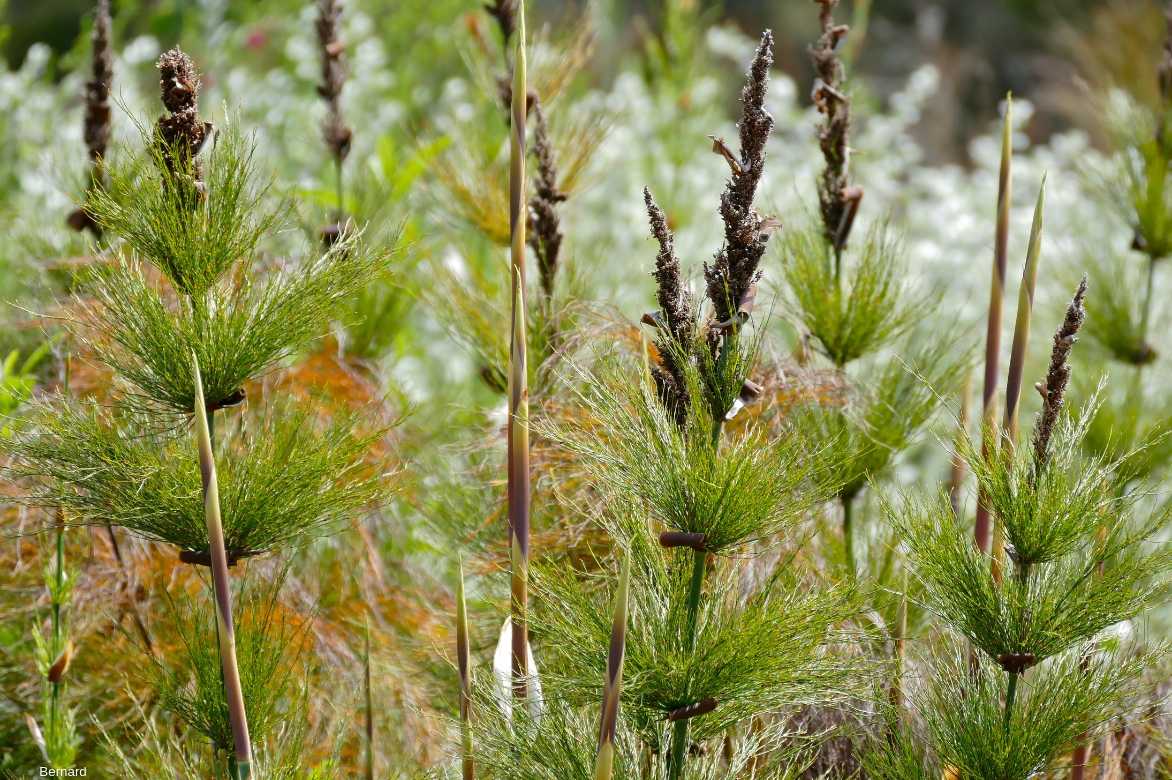
Elegia capensis with remarkable graphic appearance, midway between horsetail and bamboo
Flowers are unisexual so there are male and female plants that cannot really be distinguished before plant reaches maturity. Inflorescences, markedly different according to sex, appear in terminal position rather than being dispersed along stems as in rushes. They form spikes, panicles or clusters of spikelets in brown tones whose male flowers release pollen by wind. Naked seed has appearance of a small hazelnut but can be enclosed in a capsule, joined to other seeds depending on species. Seed sometimes bears a white elaiosome, an organ rich in proteins intended to feed ants. These carry seed back to ant nest as soon as it falls to ground, consume elaiosome and discard seed in nest waste area. Placed safe from small rodents and in a fertile medium, seed soon germinates, showing a fine example of sym symbiosis.
In South Africa, culms of large restios such as those of Cannomois grandis and robusta were used for roofing and for making brooms after drying. Thin stems of Elegia tectorum are used to make baskets. Use of restio stems in cut floristry is also very fashionable.
Read also
Agave: planting, growing, and caring forMain varieties of Restios
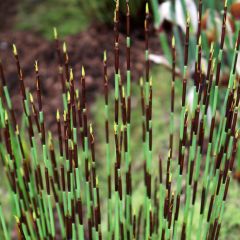
Elegia tectorum Fish Hoek
- Flowering time July to September
- Height at maturity 80 cm
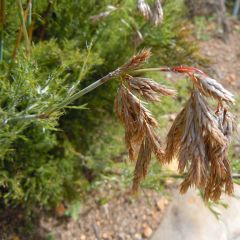
Thamnochortus cinereus - Restio
- Flowering time June, July
- Height at maturity 80 cm
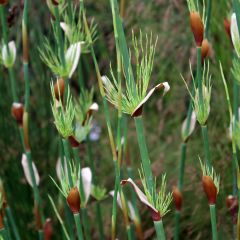
Elegia capensis
- Flowering time June, July
- Height at maturity 1,50 m
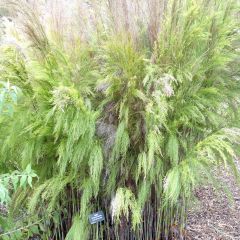
Rhodocoma capensis
- Flowering time June, July
- Height at maturity 1,50 m
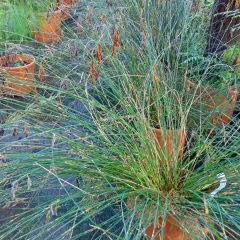
Thamnochortus pluristachyus - Restio
- Flowering time July, August
- Height at maturity 1,50 m
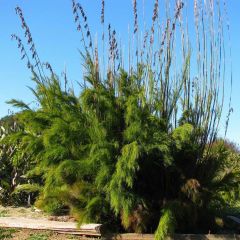
Rhodocoma gigantea - Restio
- Flowering time July, August
- Height at maturity 2,50 m
Discover other Restios
View all →Available in 1 sizes
Available in 1 sizes
Available in 2 sizes
Available in 1 sizes
Available in 1 sizes
Available in 1 sizes
Available in 1 sizes
Available in 1 sizes

Available in 1 sizes
Available in 1 sizes
Planting
Where to plant restio?
Hardiness of Restios offered ranges from -5 to -12°C, making mild Mediterranean climate or Atlantic coast well suited. Some species demand lots of humidity such as Restio tetraphyllus (which tolerates brackish water), while others occupy dry, well-drained medium. Restios require poor soil (notably low in nitrogen and phosphorus), deep and friable, generally well drained which can be clayey, silty, sandy, slightly calcareous to strongly calcareous for species Thamnocortus pluristachyus. Take care with large species such as Cannomois gigantea that can be difficult to divide or move once established because very deep, strong roots plunge forcefully into soil to seek water.
Restios favour open positions but tolerate semi-shade or even shade depending on species. They can be used as hedging or integrated into an exotic border, taking care to reserve sufficient space according to vigour.
When to plant?
Prefer spring to install restio which may not tolerate cold well. Wait until risk of frost has passed (mid-May) to plant in ground.
In a pot, repotting of young plants whose roots overflow the pot can be done in autumn.
How to plant?
- Submerge rootball in a large bucket of water to thoroughly moisten it.
- Dig a hole up to 1.50–2 m wide for large species so it can spread freely.
- Add a few shovelfuls of sand and gravel to garden soil to ensure good drainage and avoid soil becoming too fertile, which would harm plant. In native habitat, restios give way to Poaceae (grasses) when soil becomes too rich.
- Place plant in planting hole.
- Replace soil and firm lightly.
- Water.
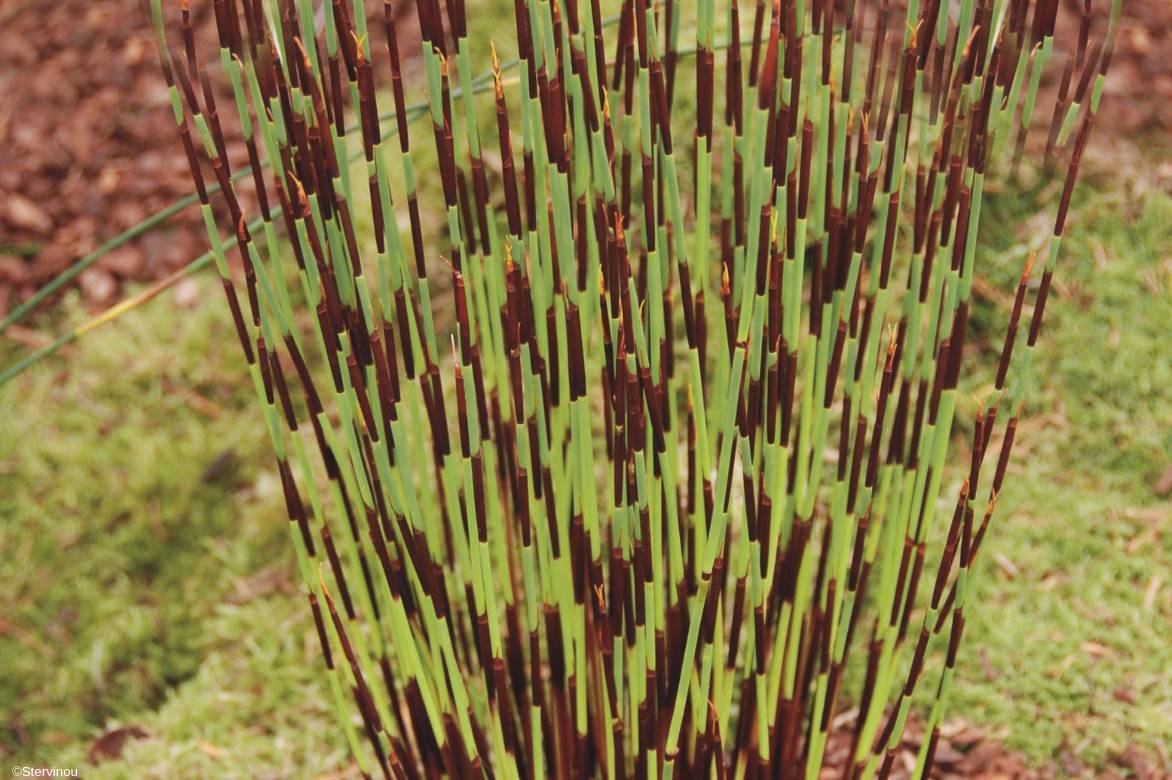
Surprising and robust South African perennial evoking horsetail or reed!
Care
- Restios have no natural enemies in our regions apart from excessive cold.
- Think of protecting young plants with a double layer of winter fleece or placing the pot in a sheltered, well-lit space that is not too warm. After excessive cold, a well-established young plant can regrow from the stump if well watered during the following season. When plant looks in poor condition, cut back stems in late autumn to mimic effect of a fire, or remove dead stems in early following spring.
- Water restios deeply and regularly when in pots to ensure good establishment. If it does not freeze over winter, these plants once well established will appreciate fresh to moist soil during winter and will cope well with the dry summer season. However a potted plant requires more frequent watering in summer.
- Even though plant is not very demanding, you can apply a fertiliser, preferably organic, low in phosphorus, or compost in spring and summer for potted plants; otherwise fertilisation is unnecessary. If shoots remain small and sparse, plant lacks water. If they take on a yellowish tinge, apply a nitrogen fertiliser or iron chelate.
- A rootstock barrier can be useful for species with rootstocks that tend to be very spreading.
Multiplication
Depending on species, restio multiplies either by sowing in spring on burnt soil or by clump division in winter. It is often a specialist task because some species do not tolerate division and die. In the fynbos, every seed is precious and subject to astonishing adaptations to avoid being eaten by rodents or germinating unnecessarily. Passage of a fire lifts dormancy of some seeds thanks to gas released by combustion of the mother plant, while ants contribute to their dispersal by consuming the elaiosome.
Division de touffe
- Dig out an adult young plant and divide rootstocks with a few cuts of a spade or pruning shear.
- Cut leafy stems to ground level and replant the stump in well-drained soil kept moist.
- One tip is to apply a trace-element-rich fertiliser (seaweed extract) once a month to encourage root growth and regrowth of stems in spring.
Sowing
- In a seed tray or outdoors, prepare a sandy substrate mixed with ashes and sow seeds.
- Keep moisture until seedling emergence, which appears after a few months as a highly ramified, feathery bush.
Uses and associations
Restios can be used on banks of water features when they favour moist soil, or to adorn edges of a swimming pool, planted in a large container kept constantly moist. They can also be used very decoratively on a terrace, to be overwintered in cold climate. They also have their place in a wild or contemporary-style garden, just like grasses.

A lovely duo: Elegia capensis and Crinum powellii (Roscoff Exotic and Botanic Garden – Brittany)
In mild climate, create a southern hemisphere scene by pairing them with flowering shrubby plants such as the striking Boronia, a kind of heath with large bright-pink bell flowers, Gomphostigma virgatum with silvery foliage constantly studded with white flowers, a Leucadendron or a Polygala, and bulbous plants such as the graceful angel’s fishing rod (Dierama), the river lily, Watsonia…

An idea for a combination in mild climate: Elegia elephantina, Beschorneria, Agave americana, Stipa tenuifolia, Yucca filamentosa ‘Bright Edge’ and Aeonium arboreum ‘Zwartkop’
In pots, compose a scene with bold, very hardy graphic plants such as horsetails, dwarf bamboos (Sasa tessellata, Pleioblastus fortunei…), small miscanthus or sedges.
Did you know?
The CCVS collection of Restionaceae is located at the Exotic Garden of Roscoff.
The name fynbos means “fine bushes” or “fine trees” in Afrikaans, probably because of this vegetation composed of heathers, restios and Proteaceae.
To go further
Discover our range of Restios.
- Subscribe!
- Contents
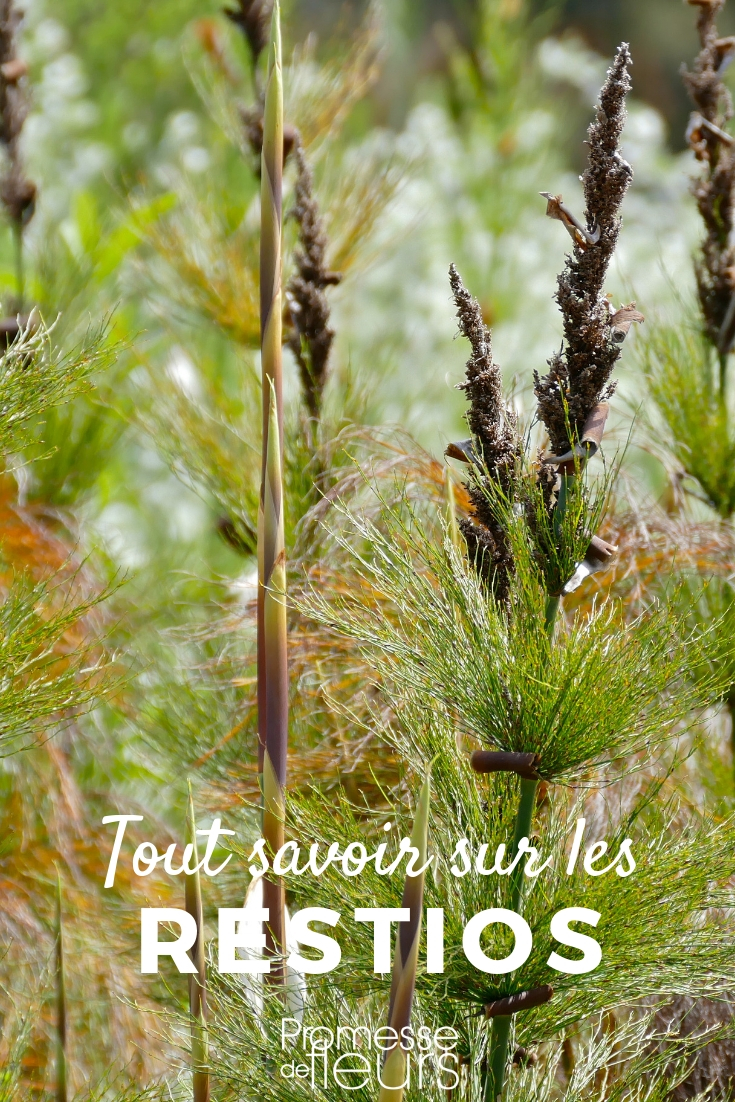


































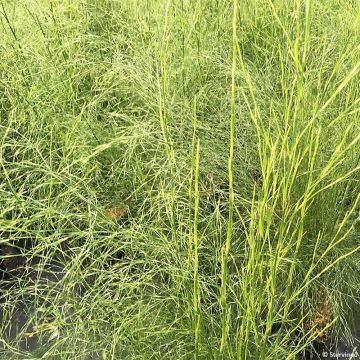



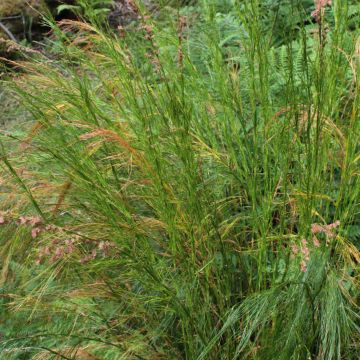

Comments